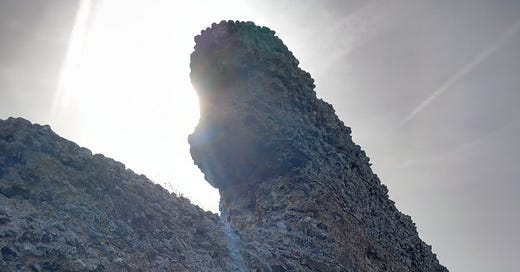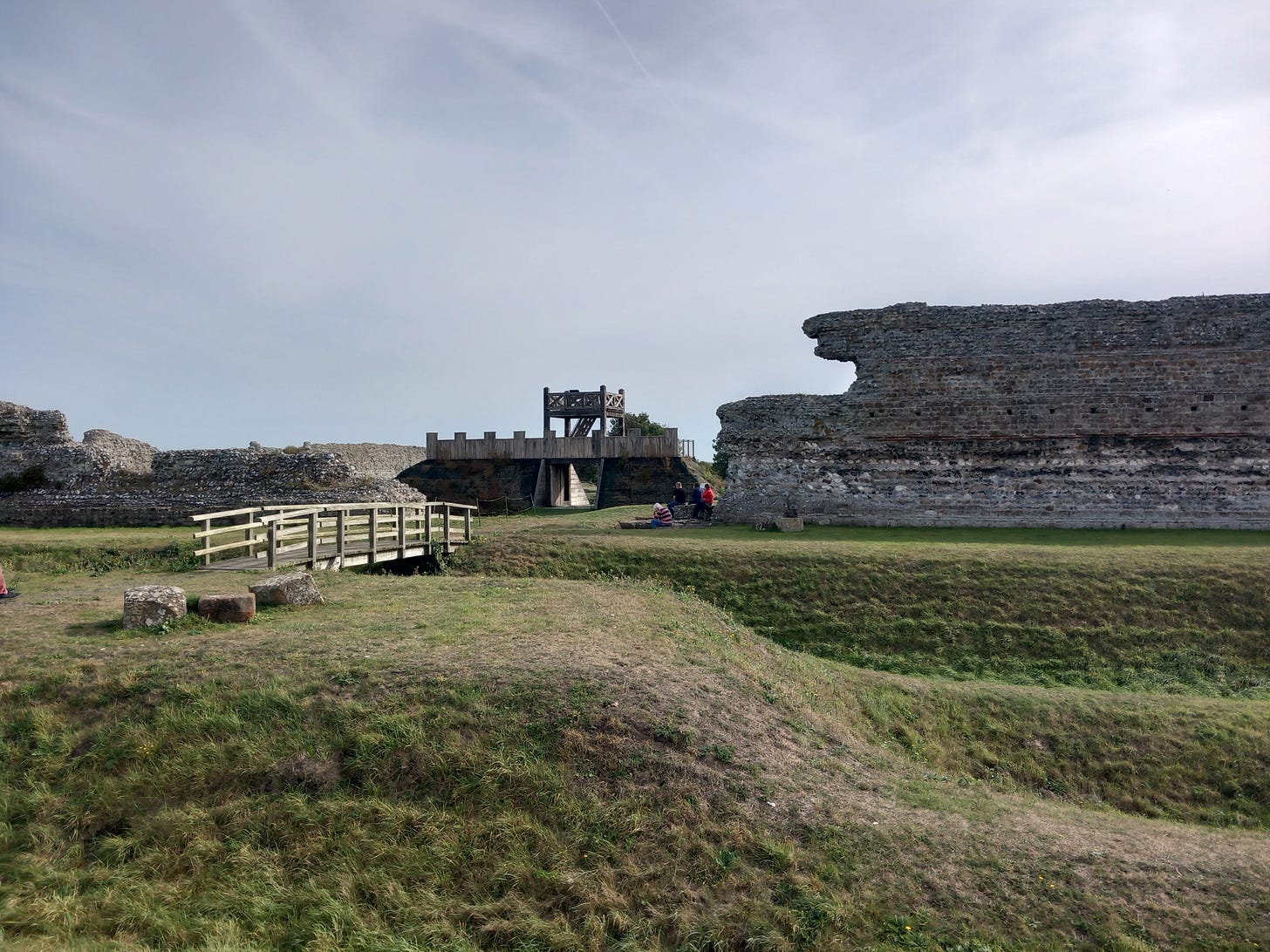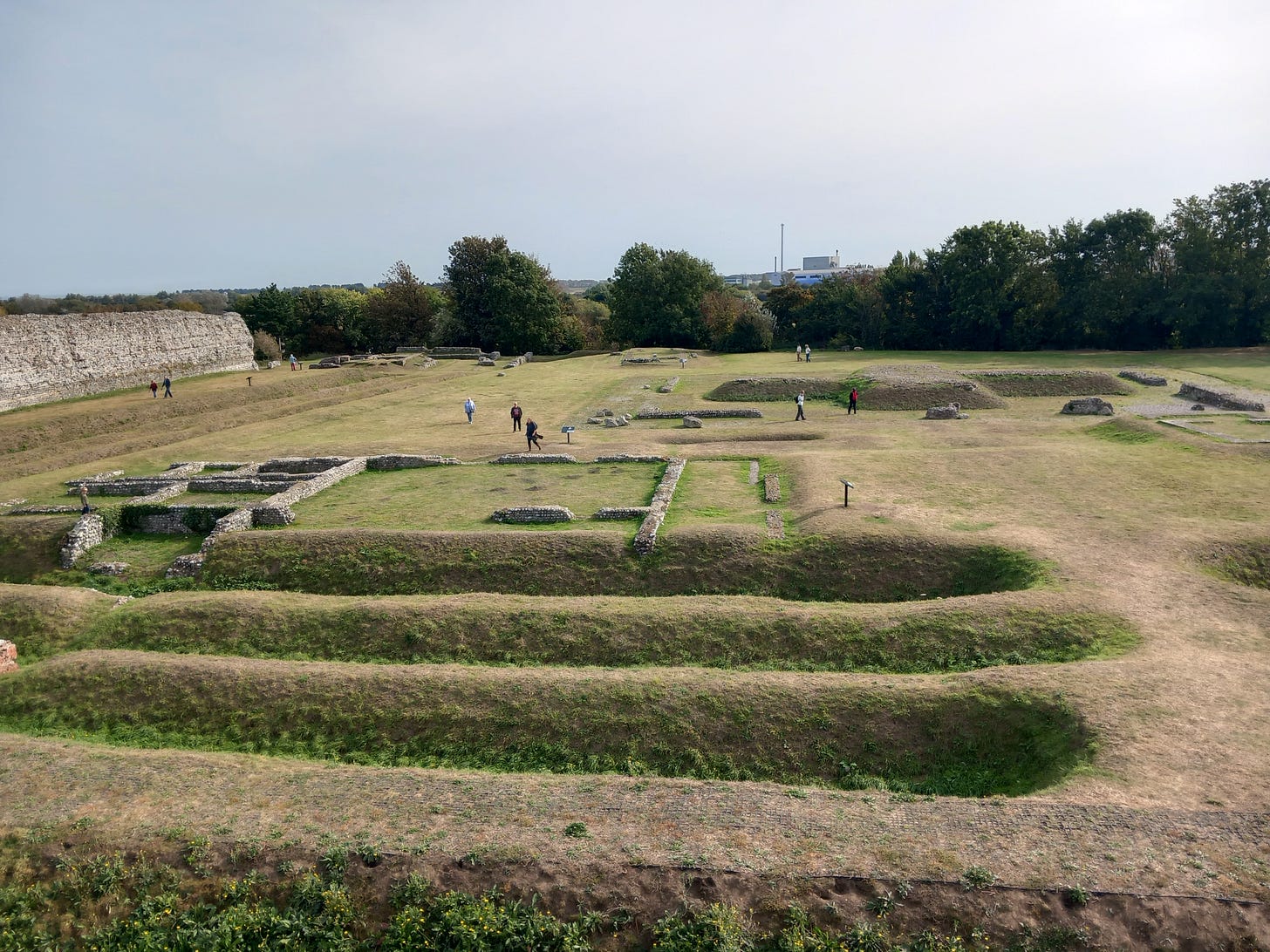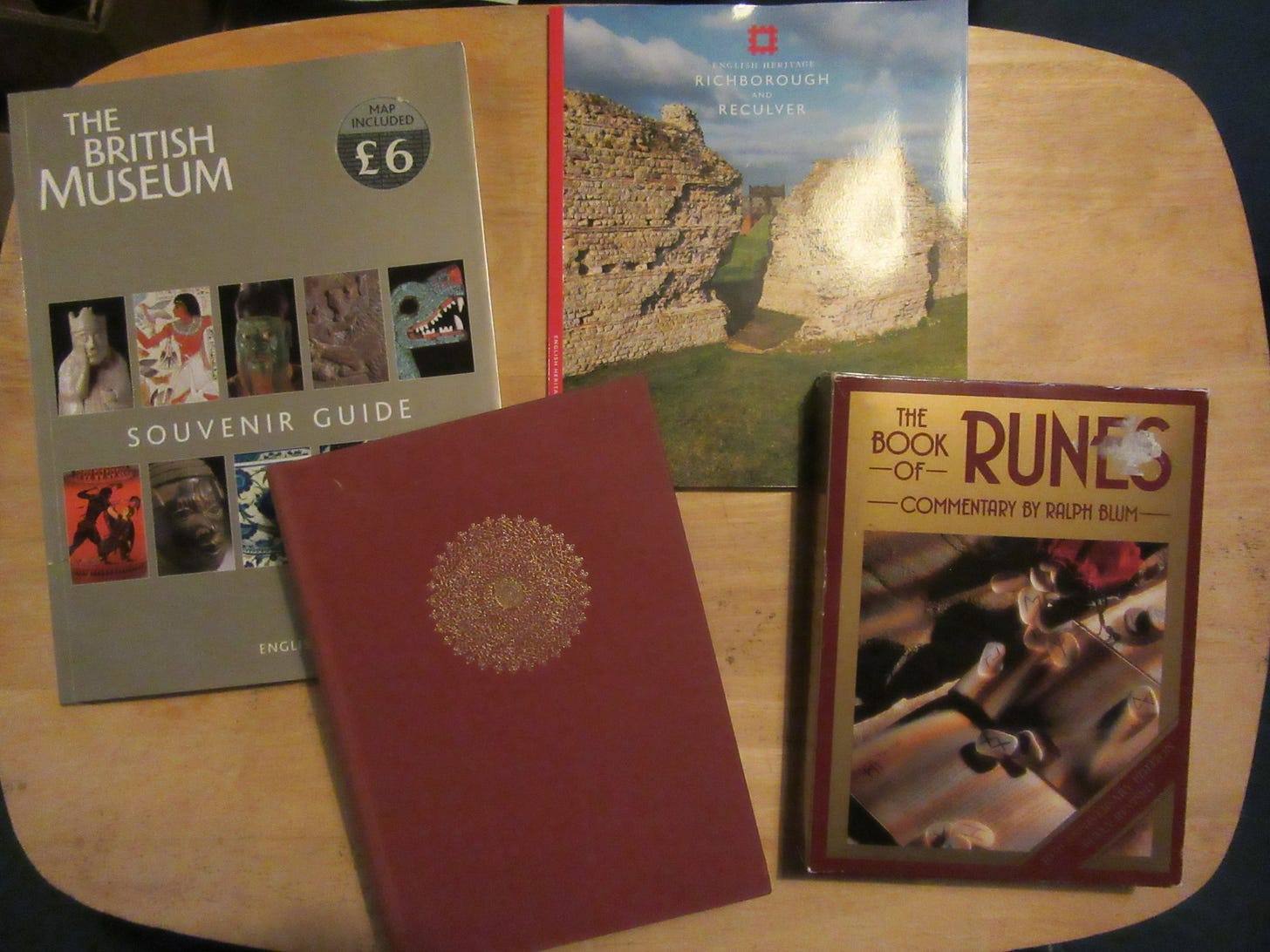Hello and welcome to the fourth of these roundups. Thanks to all my subscribers for the support. It was quite a busy week! So, I’m getting straight into it…
Richborough Roman Fort
I’d never been to this fantastic site before until last Monday. It’s somewhere just within driving range for a day out - and so I’m thankful that my family are also interested in history enough to take me. I won’t go into all the detail for you, though, dear reader.
The first thing that I noticed is the impressive height that the outer walls still have - almost as high as they would’ve been when they were built and so much taller than the surviving parts of Hadrian’s Wall that I’d seen earlier this year.
The many defensive ditches of the site have been re-dug during excavation, but they’re still impressive (you’ll see more below). The fort went through many stages during the Roman occupation (and after it), so inside the newer stone walls there’s a recreation of the first fort built there by the invading army. You can see the recreated section of bank, and wooden structure on top that would’ve been the entrance gate in the photo above.
There are many layers of history in that photo. After the initial fort, this was the gateway to Roman Britain, the start of the Roman road network. As Richborough was on an island in the channel between Thanet and the rest of Kent - it would’ve been the way to Canterbury by sea and then by road, and the same for London.
So, a town grew up around the fort - you can see a few buildings below. It would’ve been a massive place of trade, and a significant landmark. A marble arch, twenty five metres tall - supposedly the tallest in the empire - with bronze statues and decorations, would’ve stood in the centre of town as the start of the road network. You can see the raised cross on the right of my photo that was street level, the foundations around which the four legs of the arch were placed.
It would’ve been magnificent for a time - but the Romans destroyed it themselves. Firstly, they demolished the town immediately surrounding the arch and made it the centre of a new fort to defend against raiders. The three ditches above are the edge of that fort.
Then, when the Saxons were becoming more of a threat, the arch was torn town, the surrounding town once again moved, and the stone walls were set up…
However, I’ve decided to immortalise the arch in my writing. Some of you will know I’m working on a short story where a crystal travels by trade through the Roman empire and Richborough will be the market whereby it leaves Britain. (I had initially chosen Dover as it’s somewhere I know, but the arch here will perfectly link to the crystal’s final destination - Mumbai and its arch similarly built for a colonising empire; a story for another time.)
We also visited Canterbury on the way back - the crystal’s stop between London and Richborough. Here’s a link to the first post where I talk about the start of the crystal’s journey in Oxfordshire.
The Book that Made Me
So, the highlight of this week was being featured on a big Substack publication:
Firstly, I’ll thank Mikey who runs The Books That Made Us, for giving me the opportunity to write an essay about a moment, or series of moments, that so wanted to be expressed. Go subscribe if you’re not already!
And then I have to thank those who’ve subscribed because of that essay - thank you! Welcome to this newsletter. Here’s a link to my about page, for those of you new here.
It was wonderful to see how my words resonated with so many people - all the comments were so lovely; I don’t think I’ve had such a concentrated dose of praise before for something I’ve written and so I’m feeling very grateful this week for the great people on this platform.
So, how’s the research going?
I’m so glad you asked. Other than the inspiring visit to Richborough, this week has also been full of other research goodness for my book. And also finally some writing!
Besides The Books That Made Us, Thursday had another welcome surprise up its sleeve. I’ll once again link to Weekly Roundup Vol. 2, where I talked about a visit to North Leigh Roman Villa, and its relation to my writing.
I finally listened to the audio tour of the site, put together by the volunteers that look after the ruins and surviving mosaic. It was very informative and at the end gave an email with which to join a friends of the villa list. I sent over an email, mentioning briefly my story, the basic pitch, and one of the very kind volunteers got back with a helpful link and much more information confirming things for me on the site, thinking about which route the crystal could be traded (to London) from the villa.
I sent another thank you email back for the kind words and support he’d given my story and I told him more about the places in the rest of the empire I wished the crystal to travel and he sent through not only a Google drive document with all the old documents and photos of the villa but a folder of the volunteer’s trip to the Roman city of Trier in Germany - its next major stop after leaving Britain.
This was particularly pleasant as I’d visited Trier in November but my phone died shortly after before I could back up my photos - now I have all the photos I would’ve taken and more! They visited sites and museums I didn’t get around to and now I have access to all of those resources.
This weekend I’ve also finished reading the book on Roman Britain, all the way to Arthur - the Last Roman in Britain according to the book, at least based on his speculated tactics, if any of the old historical documents that later fuelled legend are truthful and can be fit to a real historical narrative. Today, I’ve been reading up just a bit more on stone circles, specifically the Neolithic ones before the Bronze Age arrived here with the Beaker people. Stone circles brings me to…
Back to writing at last
This Friday I actually properly put pen to paper - or finger to keyboard - on the aforementioned crystal short story. I’d written little snippets and obviously have been taking notes and it’s formed in my mind after recent visits. (Once again see the post from two weeks ago, linked above.) I sat down and wrote about the Devil’s Quoits stone circle - I won’t go into much detail - but after so long away I got right back into the zone, yet after finishing for the day, it didn’t feel right.
After all that time away, all the notes and imagery forming in my mind, I’d forgotten to actually plan and think through what I was writing and it turned into something that could be better, snappier, rather than a description of the site with emotions mixed in. I’m going to try again and write the whole crystal’s journey as a series of vibes and after images, objects and landmarks but not a detailed journey. I can know the exact places and what they look like, how they functioned but the reader doesn’t need to. It’s time to stop procrastinating and start creating!
This week’s books
This segment showcases the new additions to my research and fiction collections.
The British Museum guide, found in Richborough Fort’s book shed, is an older edition - but the artefacts there don’t really change much! I’ve visited the museum at least five times this year - so it’s good to flick through, refresh my memory of - and also have detailed descriptions in case I want to write about - the artefacts I’ve seen. And there’s also the guide to the fort - pretty mandatory.
The old hardcover with the flowery golden design on the front is the first volume of a translation of Leonardo Da Vinci’s notebooks. It’s actually organised into sections - so if I want his thoughts on the stars or the human hand, I can find them. I think I’ll be quoting him a fair amount in a sort of visionary pastiche that will be the last interlude short story in the novel I’m writing.
The runes are for my next novel, for next year. It’ll be nice to have physical props and a guide to read them, when that prophecy part of the historical fiction sets in.
Thanks for reading! Let me know how your week went, if you feel like it.
Cheers,
Harvey








